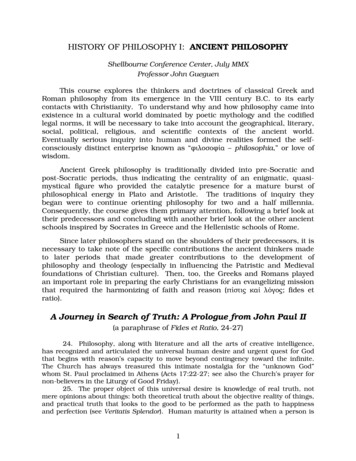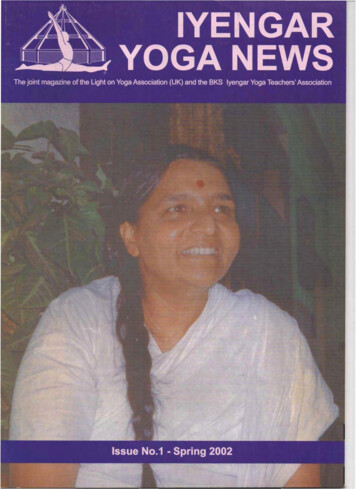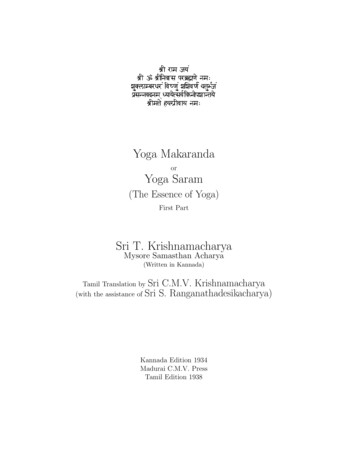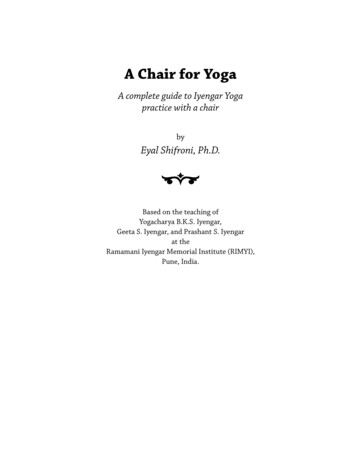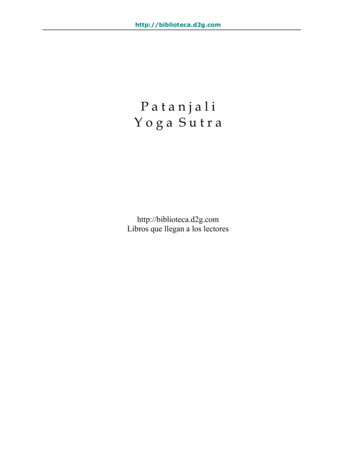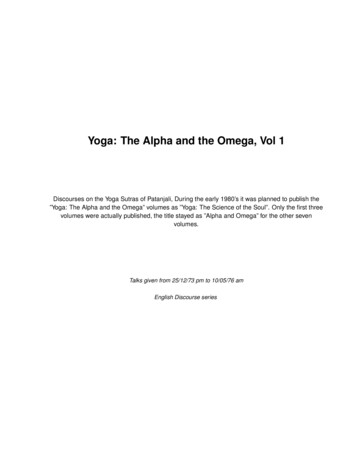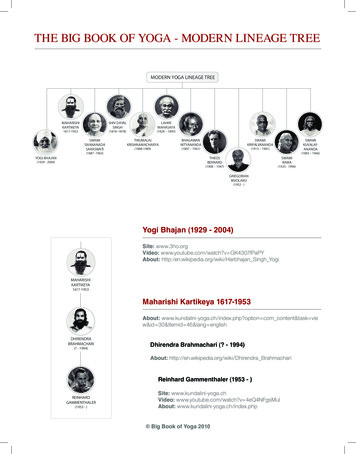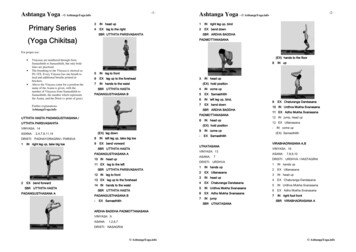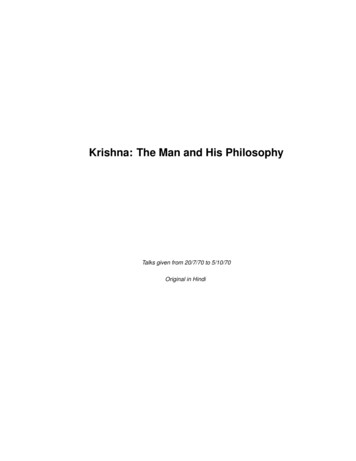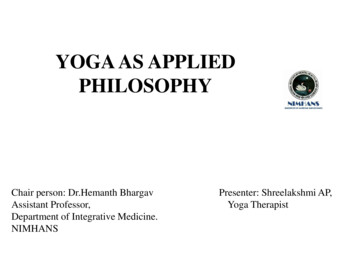
Transcription
YOGA AS APPLIEDPHILOSOPHYChair person: Dr.Hemanth BhargavAssistant Professor,Department of Integrative Medicine.NIMHANSPresenter: Shreelakshmi AP,Yoga Therapist
What is YOGA? The word yoga comes from the sanskrit root yuj, which means “to join”. Yoga is not a religion ; it is a way of living whose aim is a healthy mindin a healthy body. Yoga is a science of Holistic living and not merely set of asanas andpranayama. Yoga is conscious art of self-discovery. Yoga is an all round development of personality at physical , mentalintellectual, emotional and spiritual level.
Yoga Contd. Yoga on one hand concentrates on keeping man healthy and on other handit is a cohesion with the physical development and good habits to keephuman body healthy. Yoga science rests on the twin principles of cultivating practises(abhyasa) that bring stable tranquillity and non attachment (vairagya).(PYS 1.12)
Definitions of Yoga as perDifferent Ancient Texts1.Yum Prakrityo viyogepi YogaItyabhidhiyate Distinguishing clearly between purusha(consciouness) and prakriti (matter) is yogaand establishing purusha in his own pure stateis yoga.(Sankhya Darshana, Sage Kapila)
2.Yogaha Chitta Vrutti Nirodhaha (PYS-1.2)Yoga is calming down of mental agitations(chitta vrittis).
3.Manah prashamana upayah Yoga Iti Abhidhiyate (Yog Vashishta 3.9.32)Yoga is a skill to calm down the mind.
4. Samatvam Yoga Uchyate IIyoga-sthaḥ kuru karmāṇi saṅgaṁ tyaktvādhanañjayasiddhy-asiddhyoḥ samo bhūtvā samatvaṁ yogauchyate (Bhagvad Gita, BG: 2.48) Be steadfast in the performance of your duty, OArjun, abandoning attachment to success andfailure. Such equanimity of mind in all conditionsis called Yoga.
5. Yuktaahara viharasya yuktacheShTasyakarmasu Yuktasvapnaava bodhasya yogo bhavatidukhahaa (BG-6.17)For one who is moderate in eating andrecreation, temperate in actions, regulated insleep and wakefulness, yoga becomes thedestroyer of pain.#Moderation awareness introspection YOGA
Buddhiyukto jahatiha ubhe sukritadushkrite Tasmaatyogaaya yujyasva yogaH karmasu kaushalam (BG-2.50)A wise man, engaging in yoga transcends both good and badactions. Thus, engage in yoga, which is an art of performingactions skillfully.
Chapters in Patanjali Yoga Sutra There are 4 padas in Patanjali Yoga Sutras:1.Samadhi pada – Different types of samadhi2. Sadhana pada- Ashtanga Yoga practise3. Vibhuti pada- powers or manifestations ofSamyama on different objects4. Kaivalya pada- Process of separatingpurusha (consciousness) from prakriti (matter)
8 limbs of Yoga according to Patanjali
Yamas (moral restraints)- How to behave outwardly towards theliving beings Ahimsa: nonviolence, non harming other living beingsSatya: truthfulness, non-falsehoodAsteya:non-stealingBrahmacharya: chastity or sexual restraintAparigraha: non possessiveness
Niyamas (personal observances)-How to channelize ones own energies1.Shaucha: purity2.Santosha: contentment.3.Tapas:persistence (Raja Yoga)4.Svadhyaya:Introspection on ones ownbehaviour and studying scriptures towards bettermanagement of mind and behaviour (JnanaYoga)5.Ishvarapranidhana: Surrender to higherprinciple in Life (Bhakti Yoga)
AsanaSthiram sukham asanam: Establishing oneself in a posture which is blissfuland also if it can be maintained without any movements. (PYS 2.46)It should have no prayatna (effort) involved in final position, and thenawareness should be expanded towards infinity. (prayatna shaithilya anantasamapatti) (PYS 2.47)Such practice of asana takes an individual beyond the forces of dualities suchas pleasure and pain, hot and cold. (tato dvandva anabhighataha) (PYS2.48)
PranayamaTasminsati shwasaprashwasayorgativicchedahapranayamaha (PYS 2.49)“In that state of being in asana or posture, breaking themovement of inhalation and exhalation is regulation of breath.”1. Puraka – Inhalation2. Rechaka- Exhalation of the breath3.Kumbhaka- Holding the breath.
PratyaharaSva vishaya asamprayoge chittasya svarupeanukarah iva indriyanam pratyaharah(PYS 2.54)Pratyahara is withdrawal of the mind fromphysical senses; freed from its ties to outerobjects, the mind can arrive at its own realnature
DharanaA.Desha bandha chittasya dharana ll(PYS 3.1)Meaning: Holding the mind focussed on an object for along duration is called concentration.Characteristics of dharana are: Placing the mind on a mental object after withdrawalof senses in Pratyahara. Dharana is effortful Keeping the mind focussed on a limited area in mentalspace for long duration (e.g., OM meditation).
DhyanaTatra pratyekatanata dhyanam ll (PYS 3.2)Effortless flow of consciousness towards theobject of focus1. Dhyana is automatic process that happens afterintense Dharana for a long time2. Dhyana is effortless3. Communion between subject and object ofconcentration happens in Dhyana
SamadhiTadevarthamatranirbhasam swaroopashoonamiva samadhihi ll (PYS 3.3)Then the observer dissolves and the true natureof the object shines forth.Only the object remains subject dissolves.The triad of observer, act of observation and objectdissolves in Samadhi, all become one.
SAMYAMATrayamekatra Samyamaha ll (PYS 3.4)Samyama means dharana, dhyana and samadhi –all three together on the object of concentration.
SAMYAMA1.Kayaswaroopam sayamattadgrahyasabdhenaShakti stambhe chakshuhusamprayogentardhranamll (PYS 3.21)Meaning: By performing Samyama on the form ofones body and suspending receptivity of the forms(by absorption of light), there being no contactbetween the eye of the observer and the lightreflected from yogi’s body, the yogi can becomeinvisible.
3.Maitradishu balani (PYS 3.24)Meaning:Through Samyama on friendliness etc.,a transformation occurs in the mind andthose particular mental qualities couldbe developed. For e.g, smayama onfriendliness develops feeling ofuniversal brotherhood towards allbeings.
4. Baleshu hastibalani ll(PYS 2.25)By samyama on elephants strengthetc, the corresponding strength isdeveloped.
5.Pravritya loka nyasat sookshmavyavahitaviprakrista jnanam ll(PYS 3.26)Meaning: By Samyama on the subtlemental light advancing towards itsobjects or goal, the knowledege of thesubtle, the veiled and the distant couldbe obtained.
6.Bhuvana jnanam suryasayamat (PYS 3.27)By the samyama on the ‘Sun’,knowledge of cosmic regionsarises.
7.Chandre tara vyuha jnanam (PYS 3.28)Meaning:By samyama on the moon arises theknowledge of the arrangement of the stars.
8.Nabhicakre kayavyuha jnanam(PYS 3.30)By samyama on the navel chakra(manipura chakra) of the navel theknowledge of arrangement of pranicbody arises.
9.Kanthakoopekhsutpipasanivruttihi: (PYS 3.31)By Samyama on the throatwell(vishuddhi chakra), hunger andthirst are controlled.
10.Koorma nadyam sthiryam(PYS 3.32)Koorma nadi tubular structure justbelow throat pit (trachea).By samyama on the Kurma nadisteadiness is gained.
References:1) Integrated Approach of yogav.k.Yogas,Panaji, Goa.2) Bhagawad Gita3) Samkhya Karika4) Hatha Yoga Pradeepika5) Yog Vashishta6) Kathopanishad7) Yajnavalkiya8) Mahopanishad9) Patanjali Yog Sutras and
THANK YOU
Tasmaatyogaaya yujyasva yogaH karmasu kaushalam (BG-2.50) A wise man, engaging in yoga transcends both good and bad actions. Thus, engage in yoga, which is an art of performing actions skillfully. Chapters in Patanjali Yoga Sutra There are 4 padas in Patanjali Yoga Sutras: 1. Samadhi pada –Different types of samadhi 2. Sadhana pada-Ashtanga Yoga practise 3. Vibhuti pada- powers or .
